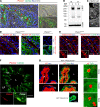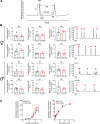Functional roles for PIEZO1 and PIEZO2 in urothelial mechanotransduction and lower urinary tract interoception
- PMID: 34464353
- PMCID: PMC8525643
- DOI: 10.1172/jci.insight.152984
Functional roles for PIEZO1 and PIEZO2 in urothelial mechanotransduction and lower urinary tract interoception
Abstract
The mechanisms that link visceral mechanosensation to the perception of internal organ status (i.e., interoception) remain elusive. In response to bladder filling, the urothelium releases ATP, which is hypothesized to stimulate voiding function by communicating the degree of bladder fullness to subjacent tissues, including afferent nerve fibers. To determine if PIEZO channels function as mechanosensors in these events, we generated conditional urothelial Piezo1-, Piezo2-, and dual Piezo1/2-knockout (KO) mice. While functional PIEZO1 channels were expressed in all urothelial cell layers, Piezo1-KO mice had a limited phenotype. Piezo2 expression was limited to a small subset of superficial umbrella cells, yet male Piezo2-KO mice exhibited incontinence (i.e., leakage) when their voiding behavior was monitored during their active dark phase. Dual Piezo1/2-KO mice had the most affected phenotype, characterized by decreased urothelial responses to mechanical stimulation, diminished ATP release, bladder hypoactivity in anesthetized Piezo1/2-KO females but not males, and urinary incontinence in both male and female Piezo1/2-KO mice during their dark phase but not inactive light one. Our studies reveal that the urothelium functions in a sex- and circadian rhythm-dependent manner to link urothelial PIEZO1/2 channel-driven mechanotransduction to normal voiding function and behavior, and in the absence of these signals, bladder dysfunction ensues.
Keywords: Cell Biology; Epithelial transport of ions and water; Signal transduction; Urology.
Conflict of interest statement
Figures







References
-
- Sherrington CS. The Integrative Action of the Nervous System. Yale University Press; 1906.
Publication types
MeSH terms
Substances
Grants and funding
LinkOut - more resources
Full Text Sources
Molecular Biology Databases
Research Materials

